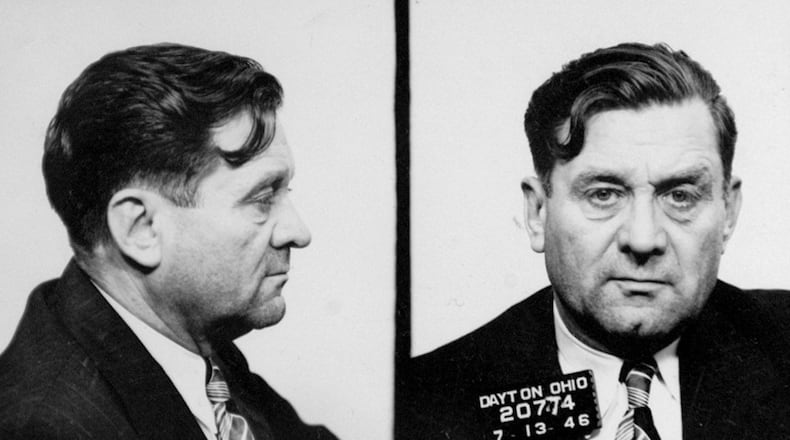After a violent gang clash with Capone, Moran fled Chicago. He ended up in Dayton several years later.
Valentine’s Day Massacre
Moran narrowly avoided death during the 1929 Valentine’s Day Massacre in Chicago.
As a bootlegger, Moran had put together the biggest still Chicago had ever seen — three warehouse floors of tubes, pipes and barrels capable of pumping out, in today’s dollars, over $1 million of alcohol each week.
His gang also was wresting control of Chicago’s laundry industry, the Poultry Union and the Kosher Meat Peddlers Association.
• PHOTOS: Gangster Bugs Moran and his Dayton connection
On the evening of Feb. 13, 1929, Moran received a phone call from a hijacker promising a truckload of stolen whiskey. He arranged to take delivery at his warehouse the next day.
Seven of Moran’s gangsters were waiting for the booze shipment inside the warehouse. Taken by surprise by four armed men in uniform, they surrendered their guns and lined up against the wall. Capone’s men killed them all.
Newspapers called it the Valentine’s Day Massacre.
Local connection
Capone had won. Chicago was mostly over for Moran. He moved back to his hometown of St. Paul, Minnesota, for a couple years and did some jail time for various crimes before returning to the outskirts of Chicago. Moran had struck a deal with Capone that he would follow his orders and not work directly in the city.
Around 1944, Al Fouts, a bootlegging fixture in the rough workingman’s taverns on West Third Street in Dayton, made his way to Chicago looking for a new liquor connection.
Credit: Handout
Credit: Handout
Moran may have been washed up, but he still knew the bootlegging business, and upon their introduction the two became friendly and talked about working together.
Visiting Dayton
In April 1946, Moran and his friend Virgil “Doc” Summers, a known murderer, decided to pay Fouts a visit at his West Fourth Street rooming house in Dayton.
Two days later, John Kurpe Jr., a 29-year-old father of three who ran Silas Tavern near Moraine’s Frigidaire plant, was robbed by the men when he walked out of Winters National Bank with $10,000 of payroll money.
The men hijacked Kurpe, using his car to drive to a stretch of woods just south of Dayton. One of the men marched Kurpe a few steps into the woods. He told Kurpe to take off his shoes, then bound his legs and hands with surgical tape, slapping a final piece over his mouth.
Kurpe eventually worked free and called the police.
Unknown to Moran at the time of the crime, the FBI had been on his tail for months, and the three men were later arrested.
The trial
The July 8, 1946, edition of the Dayton Herald trumpeted the upcoming trial to the city. A front-page story prominently featured a photo of Moran after his arrest in Henderson, Kentucky.
Days of riveting testimony combined with provocative descriptions of Moran’s wife, Evelyn, a former showgirl, wearing “a well-fitting suit that showed her slim figure to an advantage,” kept the community glued to newspaper coverage.
The crowd must have reminded Moran of the old days, and he radiated with charm. He cheerfully scolded photographers about aiming their lenses at his double-cuffed wrists. A picture like that, he said, “helps convict you right away.”
When a detective asked him if he wanted to make a statement, Moran shot back: “Do you know any more funny stories?”
The day Moran took the stand he admitted to being in Dayton at the time of the robbery but said he had no idea why the FBI agents nabbed him.
“I didn’t know why I was being arrested, but when they came in at 4:30 in the morning with machine guns and shotguns I knew it must be for something I knew nothing about,” he testified.
It took the jury just 92 minutes to find all three men guilty.
Moran and his two accomplices each received 10 years for the crime.
Upon release, Moran was immediately tried for another crime, found guilty and sentenced to the federal penitentiary at Leavenworth, Kansas, where he died a month later from lung cancer.
About the Author





